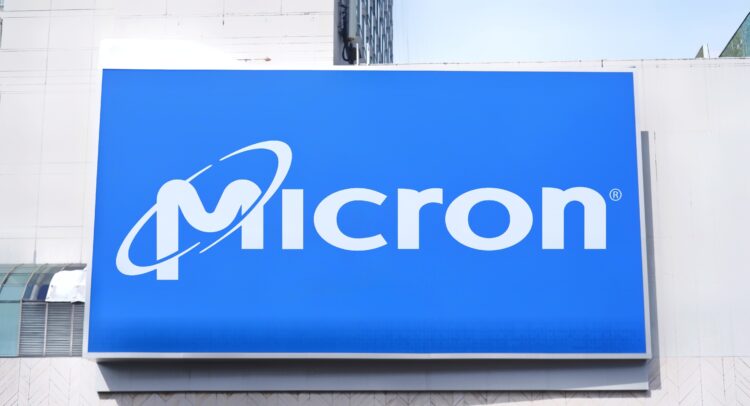
Micron Technology: Poised for Expansion in the AI and Semiconductor Industry
A Comprehensive Review of Micron’s Financial Health, Market Dynamics, and Future Prospects Amidst Rising Demand for Advanced Memory Solutions | That's TradingNEWS
Comprehensive Analysis of Micron Technology, Inc. (NASDAQ:MU)
Micron Technology, Inc. (NASDAQ:MU), a leading semiconductor company, has been a significant player in the ever-evolving tech industry, specifically within the sectors of memory and storage solutions. This detailed analysis explores Micron’s strategic market position, recent financial performance, technological advancements, and future growth prospects amid rising demands within AI-driven markets.
Current Market Landscape and Micron's Strategic Position
The artificial intelligence (AI) boom has catalyzed a substantial surge in demand for semiconductor technologies, thrusting companies like Micron into a critical position to meet the expanding needs for High Bandwidth Memory (HBM) essential in data centers. With the global sales of data centers projected to grow from $344 billion to $440 billion by 2028, Micron stands at a pivotal juncture to capitalize on these trends due to its core competencies in both DRAM and NAND memory production.
- DRAM (Dynamic Random Access Memory): Serves as primary working memory in servers and PCs, critical for short-term data processing.
- NAND Memory: Utilized for long-term data storage across various devices, crucial for ensuring data retention when systems power down.
Micron’s role extends across multiple sectors, including mobile devices, automotive industries, and significant enterprise applications, positioning the company well within the tech ecosystem.
Fiscal Year 2023 Performance Overview
Micron faced a challenging fiscal year in 2023, with sales plummeting from $30.8 billion to $15.5 billion year-over-year (YOY). This decline was influenced by an oversaturated market, reduced expenditure from key consumers anticipating economic downturns, and geopolitical tensions affecting Chinese markets. However, despite these hurdles, recent quarters have shown promising signs of recovery, driven by a resurgence in tech spending and heightened demands in AI and machine learning sectors.
Recent Earnings Performance and Future Projections
In Q3 FY24, Micron reported a robust increase in revenue, marking an 82% YOY increase to $6.8 billion. This growth is particularly notable in the data center segment, which saw a 50% increase over the prior quarter. However, the company projected cautious future guidance, which has been a pattern in its fiscal strategy, often under-promising to over-deliver as part of its market tactics.
Micron’s leadership has hinted at promising revenue streams from HBM, expected to generate "several hundred million dollars" in FY24, escalating to "multiple billions" in FY25. This projection underscores the anticipated demand for Micron's memory products, tightly intertwined with AI advancements and the expansion of data center capabilities globally.
Strategic Investments and Technological Advancements
Micron is actively enhancing its technological base, investing in advanced manufacturing facilities in Idaho and New York, set to commence production by 2027 and 2028, respectively. These developments are expected to significantly boost Micron’s production capabilities, particularly for next-generation HBM chips.
Market Dynamics and Competitive Positioning
The semiconductor industry is notoriously cyclical, and Micron has not been immune to these fluctuations. Currently, the industry is experiencing a phase of accelerated demand, particularly for memory chips used in AI applications, which has led to increased pricing power for manufacturers. Micron's strategic investments in advanced memory technologies, such as the development of its MRDIMM products, are likely to strengthen its market position against competitors and align with the growing trends towards virtualization and high-performance computing applications.
Investor Considerations and Future Outlook
Micron's current valuation reflects a mixed sentiment, influenced by its cyclical nature and the potential for substantial growth in emerging tech domains. For investors, the key considerations would include monitoring Micron's ability to manage supply chain dynamics, capitalize on AI-driven market demands, and its progress in scaling new production capabilities. With substantial investments lined up and a strategic focus on high-demand memory solutions, Micron is well-positioned to leverage the next wave of technological advancements.
In conclusion, while Micron faces challenges typical of the volatile semiconductor market, its strategic initiatives and robust position in critical memory technologies provide a strong foundation for future growth. Investors should keep a close watch on the company's execution of its expansion strategies and its ongoing adaptation to the fast-evolving tech landscape.
That's TradingNEWS
Read More
-
SCHD ETF Holds Ground With 3.6% Yield as Dividend Investors Eye Stability Over Growth
15.10.2025 · TradingNEWS ArchiveStocks
-
Ripple XRP (XRP-USD) Steadies at $2.43- SEC Shutdown Freezes ETF Decisions, Inflows Hit $61.6M
15.10.2025 · TradingNEWS ArchiveCrypto
-
NG=F Falls to $2.99 as Record Supply Outpaces Demand Despite 16.9 Bcf/d LNG Exports
15.10.2025 · TradingNEWS ArchiveCommodities
-
USD/JPY Price Forecast - Yen Weakens to 151.30 Amid Dollar Selloff
15.10.2025 · TradingNEWS ArchiveForex


















